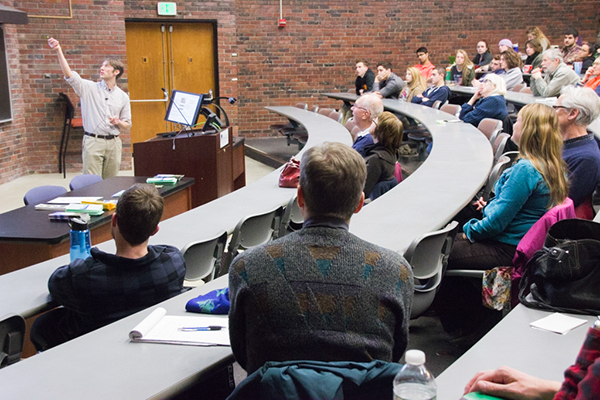
The Shawangunk Ridge: a frequent destination for many hikers, swimmers and travelers alike.
Much loved for its various hiking trails, cliff-side views and clear waters — or what used to be clear, at least.
For decades, the Mohonk Preserve and the lakes and ecosystems within it have been the subject of much environmental research and data collection. The Smiley family, for which Smiley Art Building is named, collected data and observations as well as species and weather data for over 100 years.
With the help of scientists and researchers like SUNY New Paltz’s David Richardson, assistant professor of biology and a research associate at the Mohonk Preserve, the preserve has gained more insight into the environmental factors that affect its lakes and ecosystems everyday.
In a lecture given by Richardson on Feb. 26 in Lecture Center 102 entitled “The Secrets of Sky Lakes,” he outlined three important parts of his research: acid rain and lake acidity, biological changes of the preserve and Mohonk’s lakes and climate change.
Richardson spoke to not only students and faculty of his research, but many people from surroundings communities like Poughkeepsie and Rosendale as well.
“[The sky lakes] are really important from a recreational and conservational perspective,” Richardson said. “We can learn about preservation and we can see the bigger picture. We see how the world works, how the climate is changing and what it says about our ecosystems.”
Richardson explained to his audience that the northern Shawangunks are a largely-protected area, spreading across Minnewaska State Park and the Mohonk Preserve for at least 50 miles.
He also explained that the Ridge has stayed intact over the years despite damp weather conditions because it is made of quartz conglomerate, a type of rock that is resilient to erosion.
Richardson said that fossil fuels such as sulfur and Nitrogen, which are emitted into the atmosphere while driving, have caused a low pH rain, producing acid rain and causing problems for forests and aquatic systems.
The acid rain would flow into streams and rivers, which is detrimental to fish and amphibian populations, according to Richardson.
With the acidic rain also came new species of algae and much higher algal production.
While new species of moss and algae were being introduced to Minnewaska’s ecosystems, so were different species of fish — a surprising addition considering there haven’t been sightings of fish in the lake since 1902.
In 2008 and 2009, there were sightings of golden shiners, a common type of bait fish.
Richardson said he and his team had reason to believe that fishermen introduced the bait fish into the water in hopes of catching other fish, not knowing that the lake was uninhabited.
He also said the fish were able to sustain life and procreate because of the difference in the pH levels from acid rain.
Soon after the golden shiners came a population of large mouth bass — about a 60 percent increase of bass, according to Richardson.
He said that in 2013 there were approximately 15,000 golden shiners, but after the introduction of the bass, there were a total of zero in 2014.
Another new species that found itself in the Minnewaska waters as of summer 2014 were leeches — thankfully not the blood sucking kind.
Richardson explained that this particular species of leech feed on small worms and insects, and only attach themselves to human (and animal) flesh to transport themselves from one location to the next.
“This is all really important from a recreational and cultural perspective,” Richardson said. “We learn how the biology, ecosystems and food webs work — especially when new species are introduced.”
Aside from biological changes, Richardson also talked about the climate changes in Mohonk’s lakes.
He said that Mohonk has one of the largest, most frequent and consistent records of temperature data, with the day of stratification getting earlier in the spring each year for the past 40 years.
This means that there will be and has been less ice cover each year, which is a clear indicator of climate change, according to Richardson.
“By 2063, we estimate that the lake will be stratified for 365 days of the year, meaning that there will be no ice cover whatsoever,” Richardson said.
Erin Hoagland, a stewardship and land planning associate for Dutchess Land Conservancy, attended the lecture with her father, Glenn Hoagland, the executive director of the Mohonk Preserve. Both said they were most intrigued by the information Richardson gave about lake stratification.
“[Richardson] presented a variety of information with different stories about each topic which was really engaging, rather than just showing data,” Erin Hoagland said. “The lecture was a really good refresher on aquatic ecosystems and how they work, and it was a good overview for people who don’t know about the topic.”
Overall, both said they enjoyed the lecture and found the topics interesting, especially since they work in the field of conservation.
Like Richardson, the Hoaglands find conservation to be very important in our society.
“The environment has so much purpose for our community,” Erin Hoagland said. “The health of our ecosystems makes for a healthy community.”
